Structural Health Monitoring of Bridges: Damage Identification Methods
VerifiedAdded on 2023/06/06
|15
|2900
|281
Report
AI Summary
This report provides a comprehensive overview of structural health monitoring (SHM) for bridges, a critical aspect of civil engineering. It begins by emphasizing the importance of SHM in maintaining infrastructure, highlighting the need for efficient damage detection and bridge assessment techniques. The report then explores various approaches, including direct and indirect methods, with a focus on damage identification methods such as the damage index method and the change in flexibility method. It also analyzes the dynamic response of moving vehicles on bridges, modeling the interaction between the vehicle and the bridge. Furthermore, the report delves into indirect bridge identification methods, focusing on bridge natural frequency and damping. The conclusion reinforces the importance of SHM in ensuring the safety and economic viability of bridge infrastructure. This report provides valuable insights into the techniques and technologies used in assessing bridge health.

1
Civil Engineering
Name of Student
Institution Affiliation
Civil Engineering
Name of Student
Institution Affiliation
Paraphrase This Document
Need a fresh take? Get an instant paraphrase of this document with our AI Paraphraser
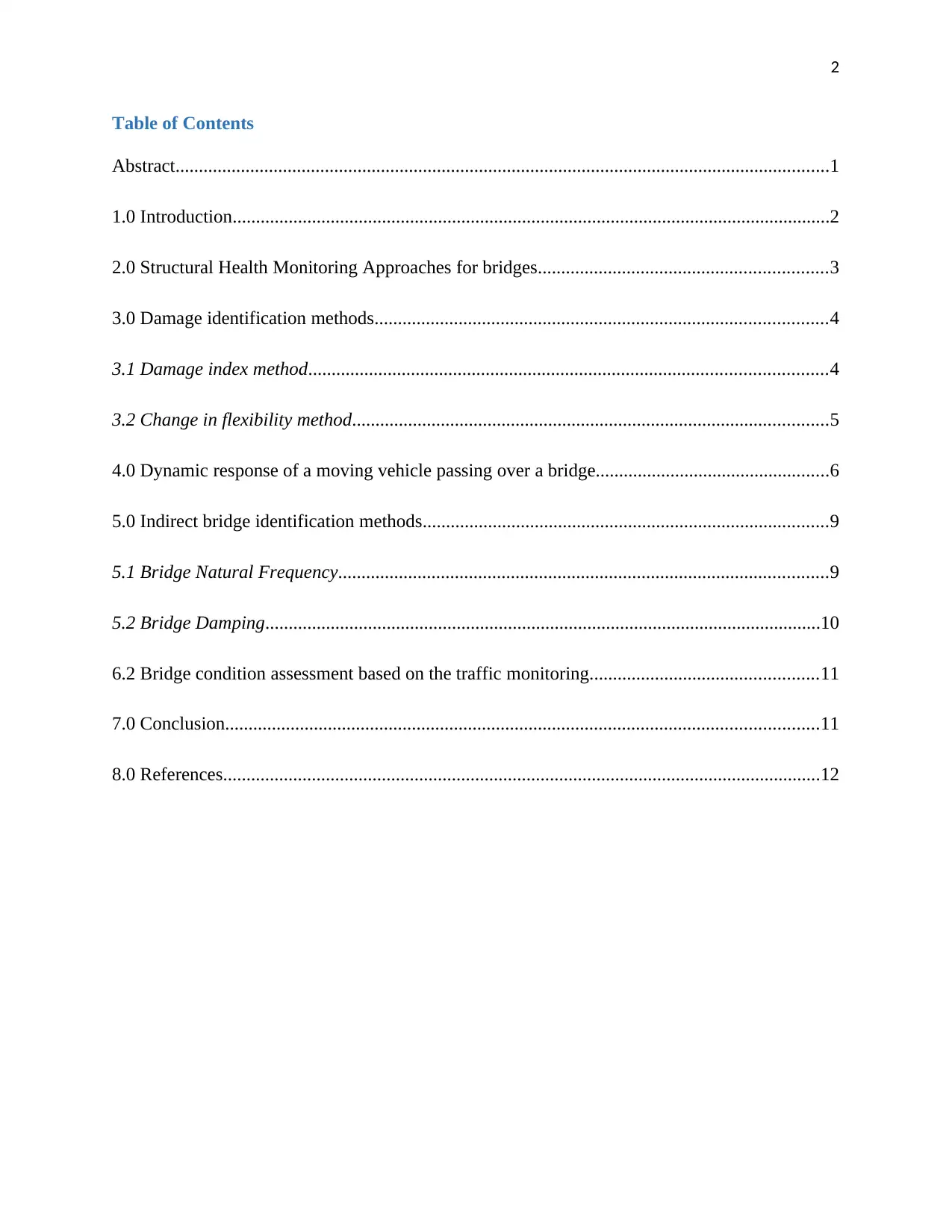
2
Table of Contents
Abstract............................................................................................................................................1
1.0 Introduction................................................................................................................................2
2.0 Structural Health Monitoring Approaches for bridges..............................................................3
3.0 Damage identification methods.................................................................................................4
3.1 Damage index method...............................................................................................................4
3.2 Change in flexibility method......................................................................................................5
4.0 Dynamic response of a moving vehicle passing over a bridge..................................................6
5.0 Indirect bridge identification methods.......................................................................................9
5.1 Bridge Natural Frequency.........................................................................................................9
5.2 Bridge Damping.......................................................................................................................10
6.2 Bridge condition assessment based on the traffic monitoring.................................................11
7.0 Conclusion...............................................................................................................................11
8.0 References................................................................................................................................12
Table of Contents
Abstract............................................................................................................................................1
1.0 Introduction................................................................................................................................2
2.0 Structural Health Monitoring Approaches for bridges..............................................................3
3.0 Damage identification methods.................................................................................................4
3.1 Damage index method...............................................................................................................4
3.2 Change in flexibility method......................................................................................................5
4.0 Dynamic response of a moving vehicle passing over a bridge..................................................6
5.0 Indirect bridge identification methods.......................................................................................9
5.1 Bridge Natural Frequency.........................................................................................................9
5.2 Bridge Damping.......................................................................................................................10
6.2 Bridge condition assessment based on the traffic monitoring.................................................11
7.0 Conclusion...............................................................................................................................11
8.0 References................................................................................................................................12
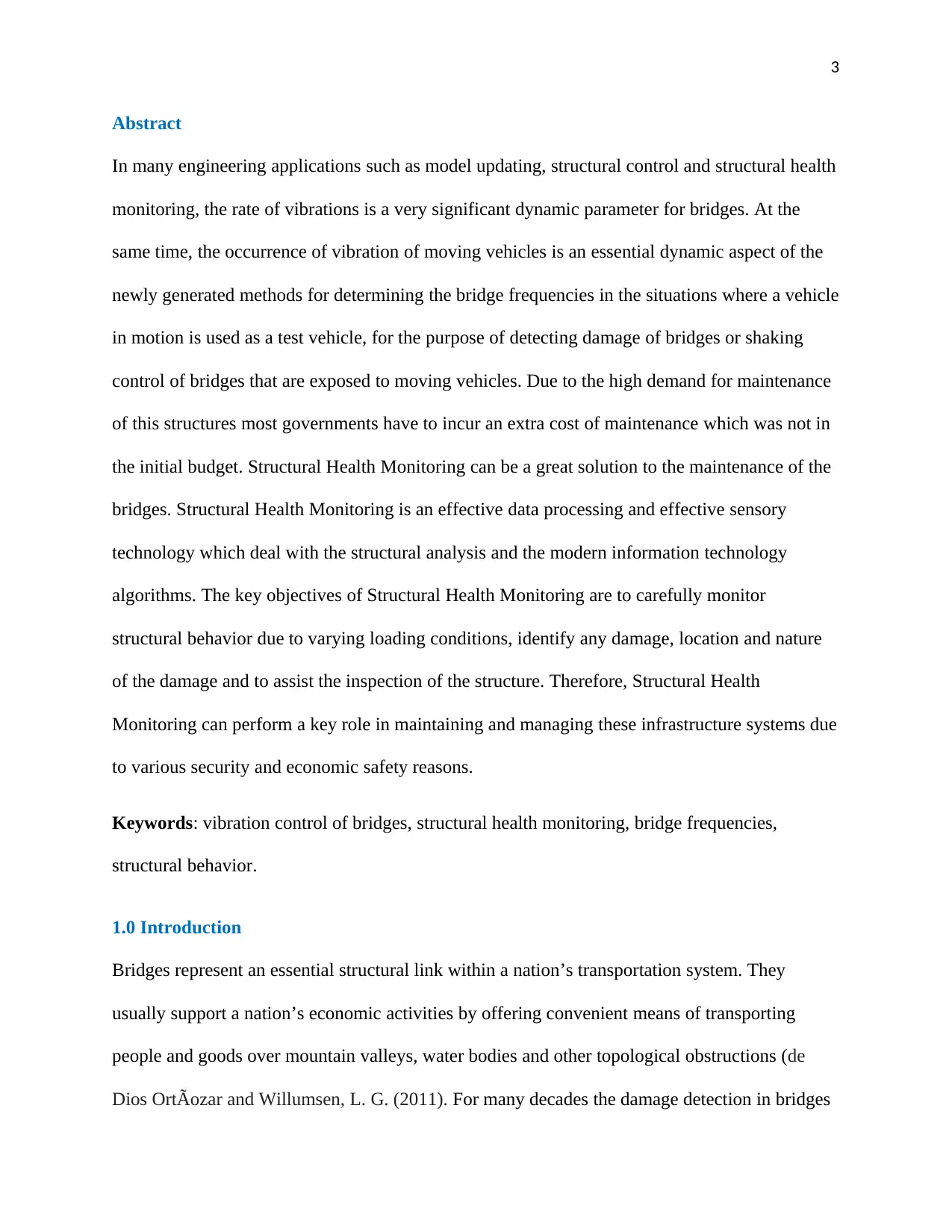
3
Abstract
In many engineering applications such as model updating, structural control and structural health
monitoring, the rate of vibrations is a very significant dynamic parameter for bridges. At the
same time, the occurrence of vibration of moving vehicles is an essential dynamic aspect of the
newly generated methods for determining the bridge frequencies in the situations where a vehicle
in motion is used as a test vehicle, for the purpose of detecting damage of bridges or shaking
control of bridges that are exposed to moving vehicles. Due to the high demand for maintenance
of this structures most governments have to incur an extra cost of maintenance which was not in
the initial budget. Structural Health Monitoring can be a great solution to the maintenance of the
bridges. Structural Health Monitoring is an effective data processing and effective sensory
technology which deal with the structural analysis and the modern information technology
algorithms. The key objectives of Structural Health Monitoring are to carefully monitor
structural behavior due to varying loading conditions, identify any damage, location and nature
of the damage and to assist the inspection of the structure. Therefore, Structural Health
Monitoring can perform a key role in maintaining and managing these infrastructure systems due
to various security and economic safety reasons.
Keywords: vibration control of bridges, structural health monitoring, bridge frequencies,
structural behavior.
1.0 Introduction
Bridges represent an essential structural link within a nation’s transportation system. They
usually support a nation’s economic activities by offering convenient means of transporting
people and goods over mountain valleys, water bodies and other topological obstructions (de
Dios OrtÃozar and Willumsen, L. G. (2011). For many decades the damage detection in bridges
Abstract
In many engineering applications such as model updating, structural control and structural health
monitoring, the rate of vibrations is a very significant dynamic parameter for bridges. At the
same time, the occurrence of vibration of moving vehicles is an essential dynamic aspect of the
newly generated methods for determining the bridge frequencies in the situations where a vehicle
in motion is used as a test vehicle, for the purpose of detecting damage of bridges or shaking
control of bridges that are exposed to moving vehicles. Due to the high demand for maintenance
of this structures most governments have to incur an extra cost of maintenance which was not in
the initial budget. Structural Health Monitoring can be a great solution to the maintenance of the
bridges. Structural Health Monitoring is an effective data processing and effective sensory
technology which deal with the structural analysis and the modern information technology
algorithms. The key objectives of Structural Health Monitoring are to carefully monitor
structural behavior due to varying loading conditions, identify any damage, location and nature
of the damage and to assist the inspection of the structure. Therefore, Structural Health
Monitoring can perform a key role in maintaining and managing these infrastructure systems due
to various security and economic safety reasons.
Keywords: vibration control of bridges, structural health monitoring, bridge frequencies,
structural behavior.
1.0 Introduction
Bridges represent an essential structural link within a nation’s transportation system. They
usually support a nation’s economic activities by offering convenient means of transporting
people and goods over mountain valleys, water bodies and other topological obstructions (de
Dios OrtÃozar and Willumsen, L. G. (2011). For many decades the damage detection in bridges
⊘ This is a preview!⊘
Do you want full access?
Subscribe today to unlock all pages.

Trusted by 1+ million students worldwide
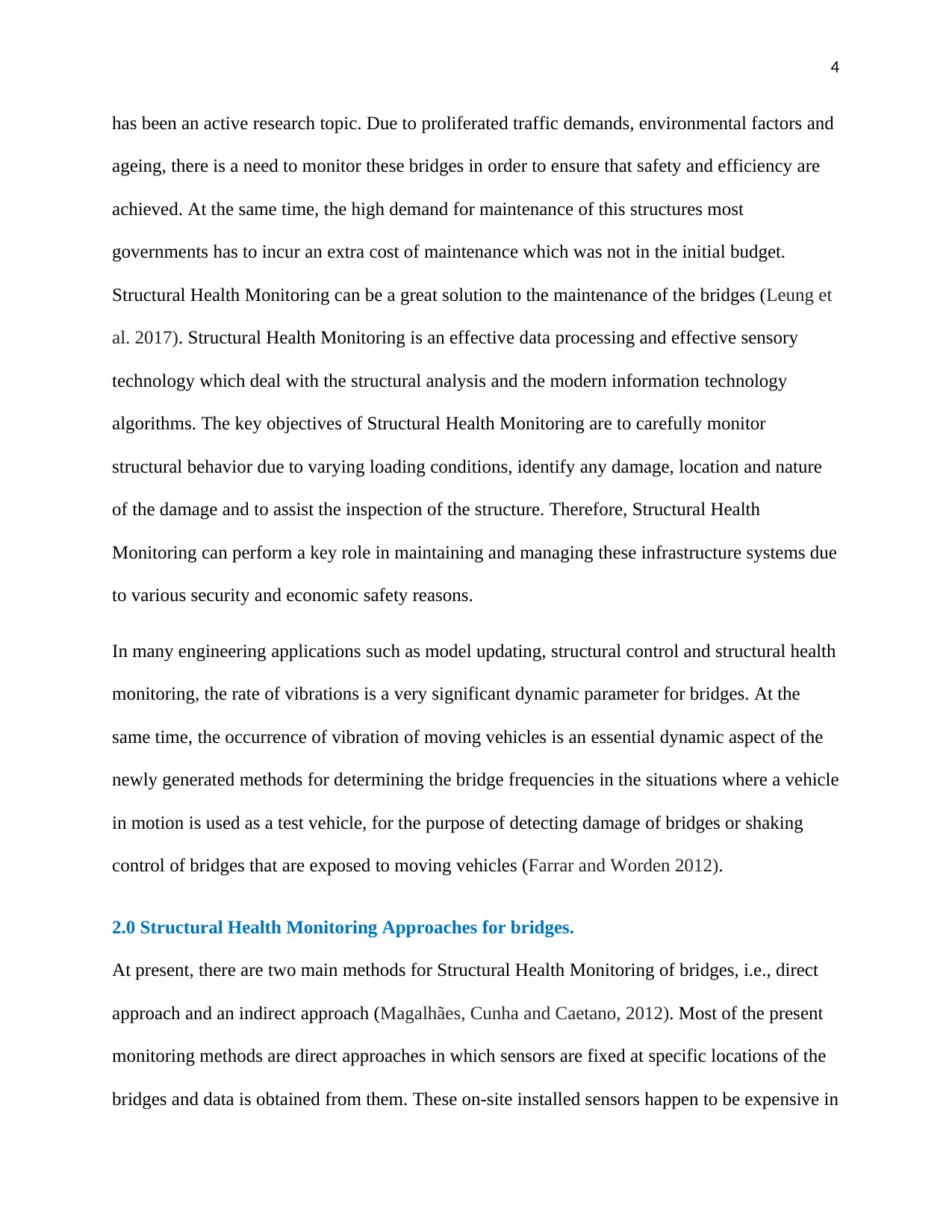
4
has been an active research topic. Due to proliferated traffic demands, environmental factors and
ageing, there is a need to monitor these bridges in order to ensure that safety and efficiency are
achieved. At the same time, the high demand for maintenance of this structures most
governments has to incur an extra cost of maintenance which was not in the initial budget.
Structural Health Monitoring can be a great solution to the maintenance of the bridges (Leung et
al. 2017). Structural Health Monitoring is an effective data processing and effective sensory
technology which deal with the structural analysis and the modern information technology
algorithms. The key objectives of Structural Health Monitoring are to carefully monitor
structural behavior due to varying loading conditions, identify any damage, location and nature
of the damage and to assist the inspection of the structure. Therefore, Structural Health
Monitoring can perform a key role in maintaining and managing these infrastructure systems due
to various security and economic safety reasons.
In many engineering applications such as model updating, structural control and structural health
monitoring, the rate of vibrations is a very significant dynamic parameter for bridges. At the
same time, the occurrence of vibration of moving vehicles is an essential dynamic aspect of the
newly generated methods for determining the bridge frequencies in the situations where a vehicle
in motion is used as a test vehicle, for the purpose of detecting damage of bridges or shaking
control of bridges that are exposed to moving vehicles (Farrar and Worden 2012).
2.0 Structural Health Monitoring Approaches for bridges.
At present, there are two main methods for Structural Health Monitoring of bridges, i.e., direct
approach and an indirect approach (Magalhães, Cunha and Caetano, 2012). Most of the present
monitoring methods are direct approaches in which sensors are fixed at specific locations of the
bridges and data is obtained from them. These on-site installed sensors happen to be expensive in
has been an active research topic. Due to proliferated traffic demands, environmental factors and
ageing, there is a need to monitor these bridges in order to ensure that safety and efficiency are
achieved. At the same time, the high demand for maintenance of this structures most
governments has to incur an extra cost of maintenance which was not in the initial budget.
Structural Health Monitoring can be a great solution to the maintenance of the bridges (Leung et
al. 2017). Structural Health Monitoring is an effective data processing and effective sensory
technology which deal with the structural analysis and the modern information technology
algorithms. The key objectives of Structural Health Monitoring are to carefully monitor
structural behavior due to varying loading conditions, identify any damage, location and nature
of the damage and to assist the inspection of the structure. Therefore, Structural Health
Monitoring can perform a key role in maintaining and managing these infrastructure systems due
to various security and economic safety reasons.
In many engineering applications such as model updating, structural control and structural health
monitoring, the rate of vibrations is a very significant dynamic parameter for bridges. At the
same time, the occurrence of vibration of moving vehicles is an essential dynamic aspect of the
newly generated methods for determining the bridge frequencies in the situations where a vehicle
in motion is used as a test vehicle, for the purpose of detecting damage of bridges or shaking
control of bridges that are exposed to moving vehicles (Farrar and Worden 2012).
2.0 Structural Health Monitoring Approaches for bridges.
At present, there are two main methods for Structural Health Monitoring of bridges, i.e., direct
approach and an indirect approach (Magalhães, Cunha and Caetano, 2012). Most of the present
monitoring methods are direct approaches in which sensors are fixed at specific locations of the
bridges and data is obtained from them. These on-site installed sensors happen to be expensive in
Paraphrase This Document
Need a fresh take? Get an instant paraphrase of this document with our AI Paraphraser
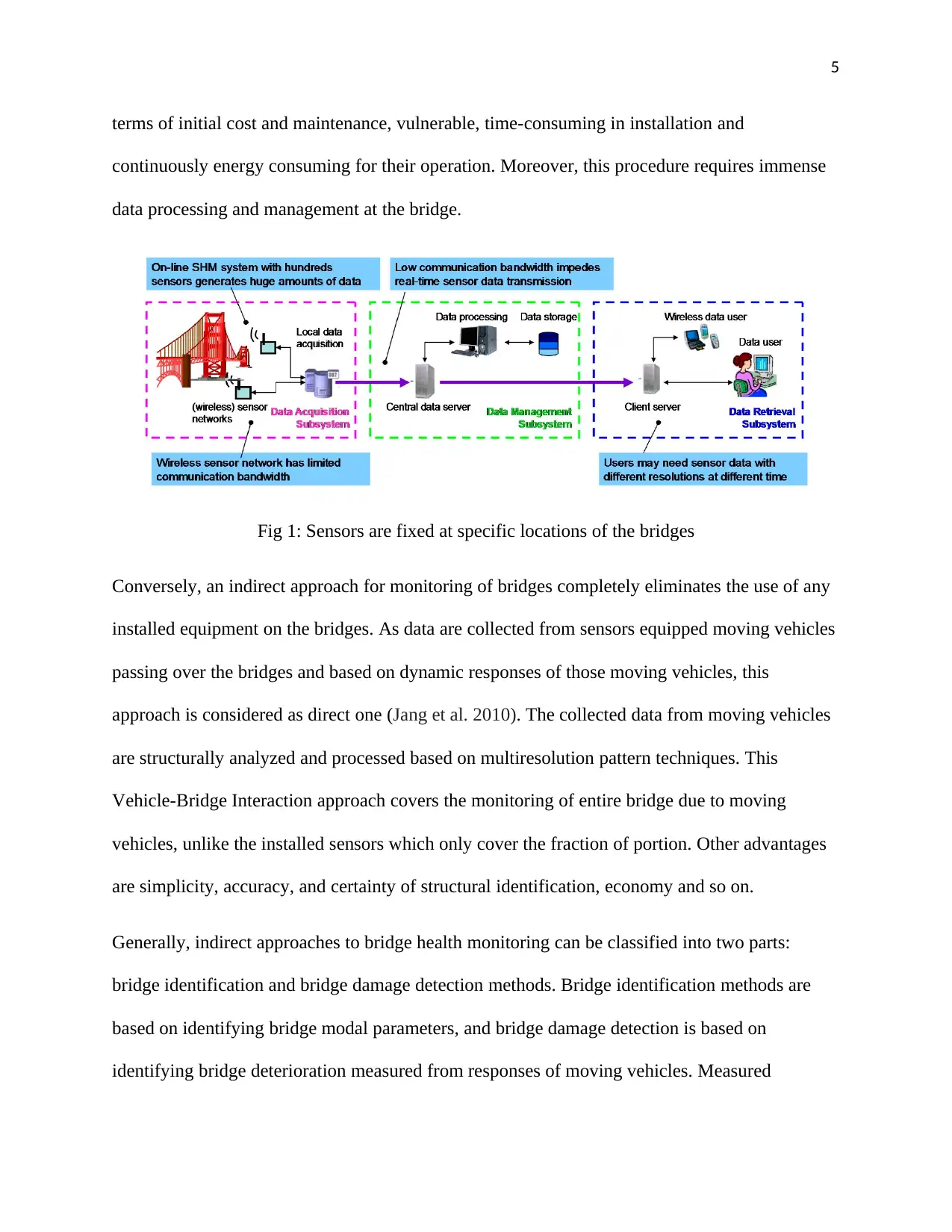
5
terms of initial cost and maintenance, vulnerable, time-consuming in installation and
continuously energy consuming for their operation. Moreover, this procedure requires immense
data processing and management at the bridge.
Fig 1: Sensors are fixed at specific locations of the bridges
Conversely, an indirect approach for monitoring of bridges completely eliminates the use of any
installed equipment on the bridges. As data are collected from sensors equipped moving vehicles
passing over the bridges and based on dynamic responses of those moving vehicles, this
approach is considered as direct one (Jang et al. 2010). The collected data from moving vehicles
are structurally analyzed and processed based on multiresolution pattern techniques. This
Vehicle-Bridge Interaction approach covers the monitoring of entire bridge due to moving
vehicles, unlike the installed sensors which only cover the fraction of portion. Other advantages
are simplicity, accuracy, and certainty of structural identification, economy and so on.
Generally, indirect approaches to bridge health monitoring can be classified into two parts:
bridge identification and bridge damage detection methods. Bridge identification methods are
based on identifying bridge modal parameters, and bridge damage detection is based on
identifying bridge deterioration measured from responses of moving vehicles. Measured
terms of initial cost and maintenance, vulnerable, time-consuming in installation and
continuously energy consuming for their operation. Moreover, this procedure requires immense
data processing and management at the bridge.
Fig 1: Sensors are fixed at specific locations of the bridges
Conversely, an indirect approach for monitoring of bridges completely eliminates the use of any
installed equipment on the bridges. As data are collected from sensors equipped moving vehicles
passing over the bridges and based on dynamic responses of those moving vehicles, this
approach is considered as direct one (Jang et al. 2010). The collected data from moving vehicles
are structurally analyzed and processed based on multiresolution pattern techniques. This
Vehicle-Bridge Interaction approach covers the monitoring of entire bridge due to moving
vehicles, unlike the installed sensors which only cover the fraction of portion. Other advantages
are simplicity, accuracy, and certainty of structural identification, economy and so on.
Generally, indirect approaches to bridge health monitoring can be classified into two parts:
bridge identification and bridge damage detection methods. Bridge identification methods are
based on identifying bridge modal parameters, and bridge damage detection is based on
identifying bridge deterioration measured from responses of moving vehicles. Measured
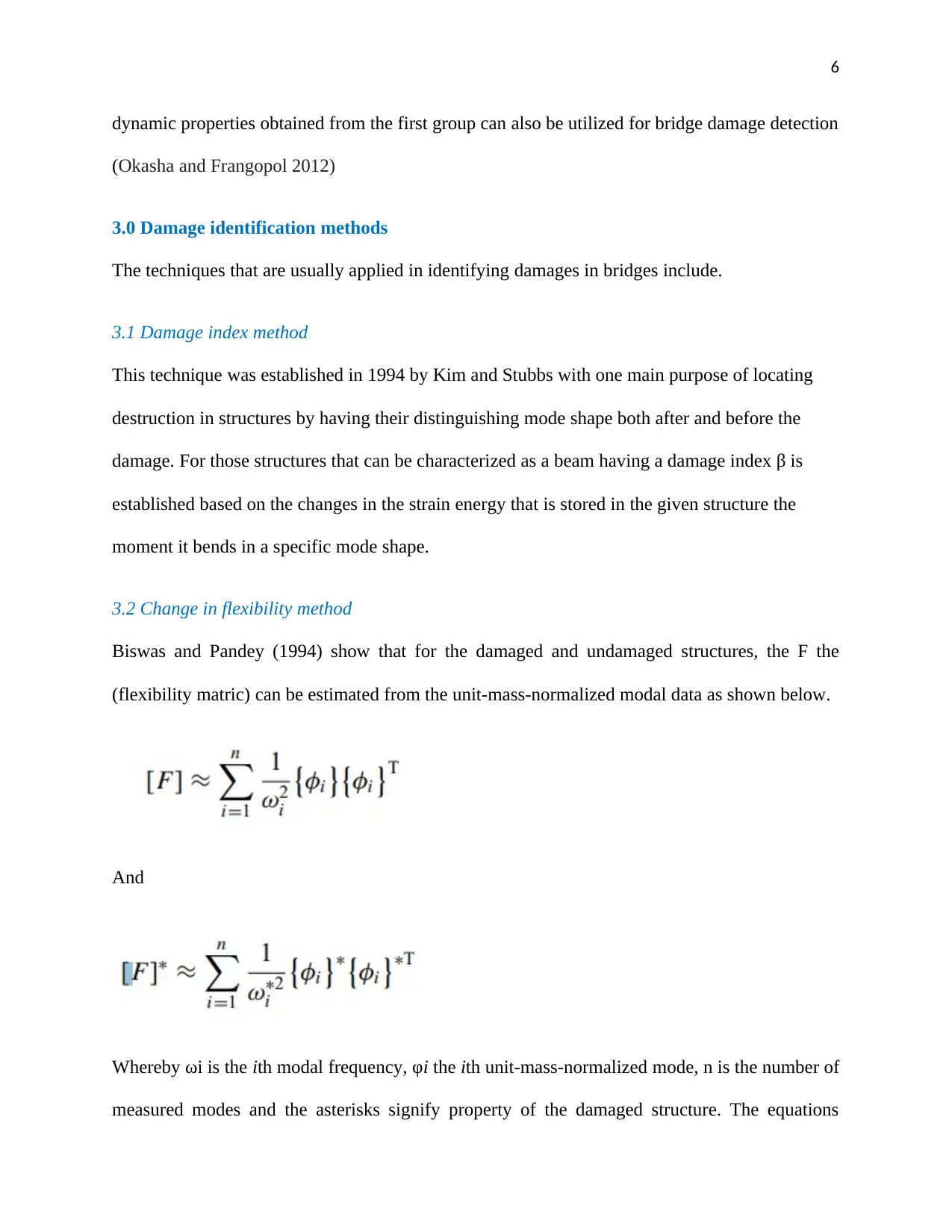
6
dynamic properties obtained from the first group can also be utilized for bridge damage detection
(Okasha and Frangopol 2012)
3.0 Damage identification methods
The techniques that are usually applied in identifying damages in bridges include.
3.1 Damage index method
This technique was established in 1994 by Kim and Stubbs with one main purpose of locating
destruction in structures by having their distinguishing mode shape both after and before the
damage. For those structures that can be characterized as a beam having a damage index β is
established based on the changes in the strain energy that is stored in the given structure the
moment it bends in a specific mode shape.
3.2 Change in flexibility method
Biswas and Pandey (1994) show that for the damaged and undamaged structures, the F the
(flexibility matric) can be estimated from the unit-mass-normalized modal data as shown below.
And
Whereby ωi is the ith modal frequency, φi the ith unit-mass-normalized mode, n is the number of
measured modes and the asterisks signify property of the damaged structure. The equations
dynamic properties obtained from the first group can also be utilized for bridge damage detection
(Okasha and Frangopol 2012)
3.0 Damage identification methods
The techniques that are usually applied in identifying damages in bridges include.
3.1 Damage index method
This technique was established in 1994 by Kim and Stubbs with one main purpose of locating
destruction in structures by having their distinguishing mode shape both after and before the
damage. For those structures that can be characterized as a beam having a damage index β is
established based on the changes in the strain energy that is stored in the given structure the
moment it bends in a specific mode shape.
3.2 Change in flexibility method
Biswas and Pandey (1994) show that for the damaged and undamaged structures, the F the
(flexibility matric) can be estimated from the unit-mass-normalized modal data as shown below.
And
Whereby ωi is the ith modal frequency, φi the ith unit-mass-normalized mode, n is the number of
measured modes and the asterisks signify property of the damaged structure. The equations
⊘ This is a preview!⊘
Do you want full access?
Subscribe today to unlock all pages.

Trusted by 1+ million students worldwide

7
presented above are estimations because fewer modes are typically identified as compared to the
total number of measurements degrees or points of freedom.
Whereby represents the change in the flexibility matrix. For a column with matrix
is defined to be the absolute maximum value of the elements in the given column (Guo, Xiao,
and Yao, 2011). Thus
Whereby are the elements of the matrix and is then taken as the measure of
flexibility change at each given measurement location.
4.0 Dynamic response of a moving vehicle passing over a bridge
by considering a moving vehicle over a bridge as a sprung mass and bridge as a simply
supported as shown in the figure below, the following equation was generated.
Whereby mv, and qv are mass, stiffness, and displacement of sprung mass respectively and qb |x=vt
is beam deflection where sprung mass is located. By further expressing Eq. 2 by taking into
account the contact force between this simply supported beam and sprung mass.
presented above are estimations because fewer modes are typically identified as compared to the
total number of measurements degrees or points of freedom.
Whereby represents the change in the flexibility matrix. For a column with matrix
is defined to be the absolute maximum value of the elements in the given column (Guo, Xiao,
and Yao, 2011). Thus
Whereby are the elements of the matrix and is then taken as the measure of
flexibility change at each given measurement location.
4.0 Dynamic response of a moving vehicle passing over a bridge
by considering a moving vehicle over a bridge as a sprung mass and bridge as a simply
supported as shown in the figure below, the following equation was generated.
Whereby mv, and qv are mass, stiffness, and displacement of sprung mass respectively and qb |x=vt
is beam deflection where sprung mass is located. By further expressing Eq. 2 by taking into
account the contact force between this simply supported beam and sprung mass.
Paraphrase This Document
Need a fresh take? Get an instant paraphrase of this document with our AI Paraphraser
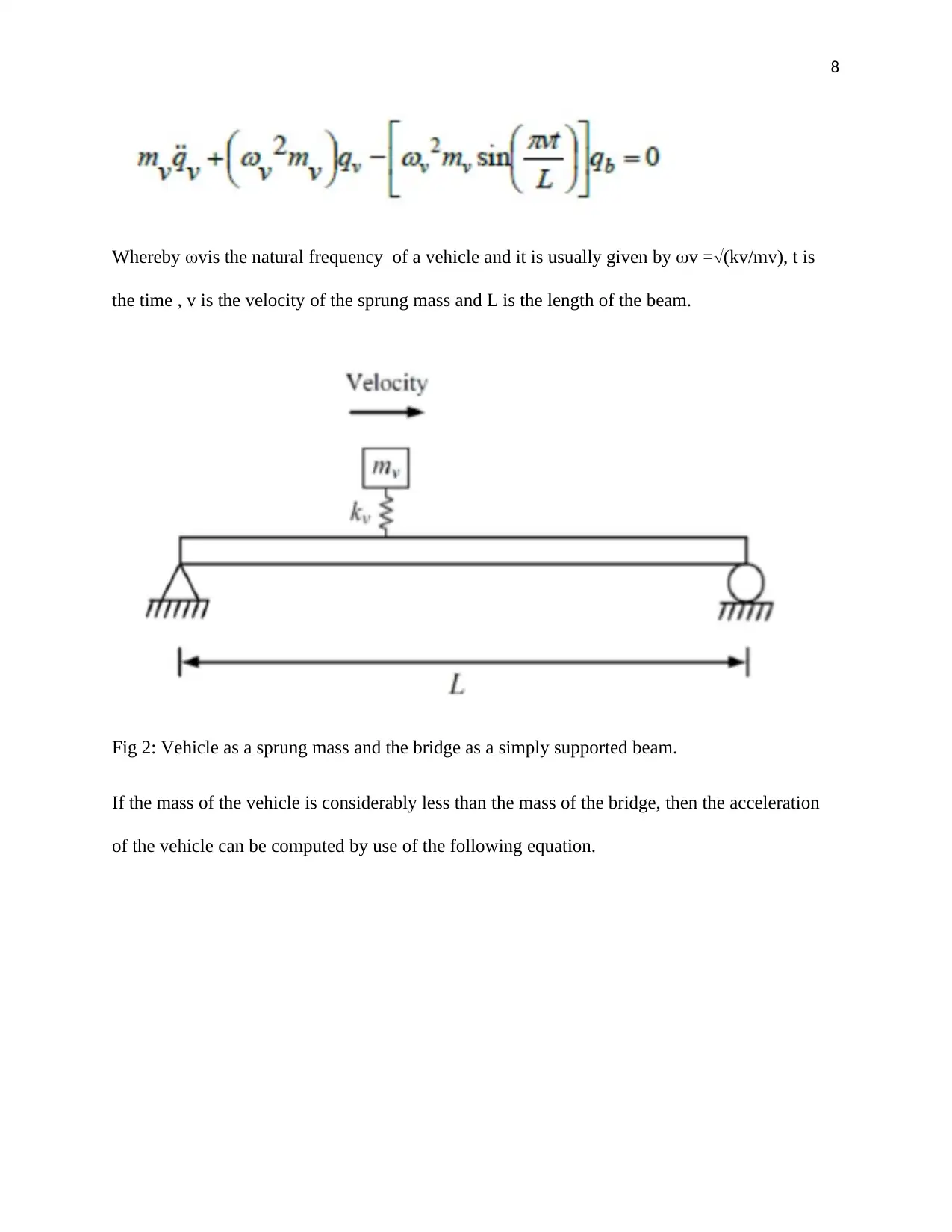
8
Whereby vis the natural frequency of a vehicle and it is usually given by v =(kv/mv), t is
the time , v is the velocity of the sprung mass and L is the length of the beam.
Fig 2: Vehicle as a sprung mass and the bridge as a simply supported beam.
If the mass of the vehicle is considerably less than the mass of the bridge, then the acceleration
of the vehicle can be computed by use of the following equation.
Whereby vis the natural frequency of a vehicle and it is usually given by v =(kv/mv), t is
the time , v is the velocity of the sprung mass and L is the length of the beam.
Fig 2: Vehicle as a sprung mass and the bridge as a simply supported beam.
If the mass of the vehicle is considerably less than the mass of the bridge, then the acceleration
of the vehicle can be computed by use of the following equation.
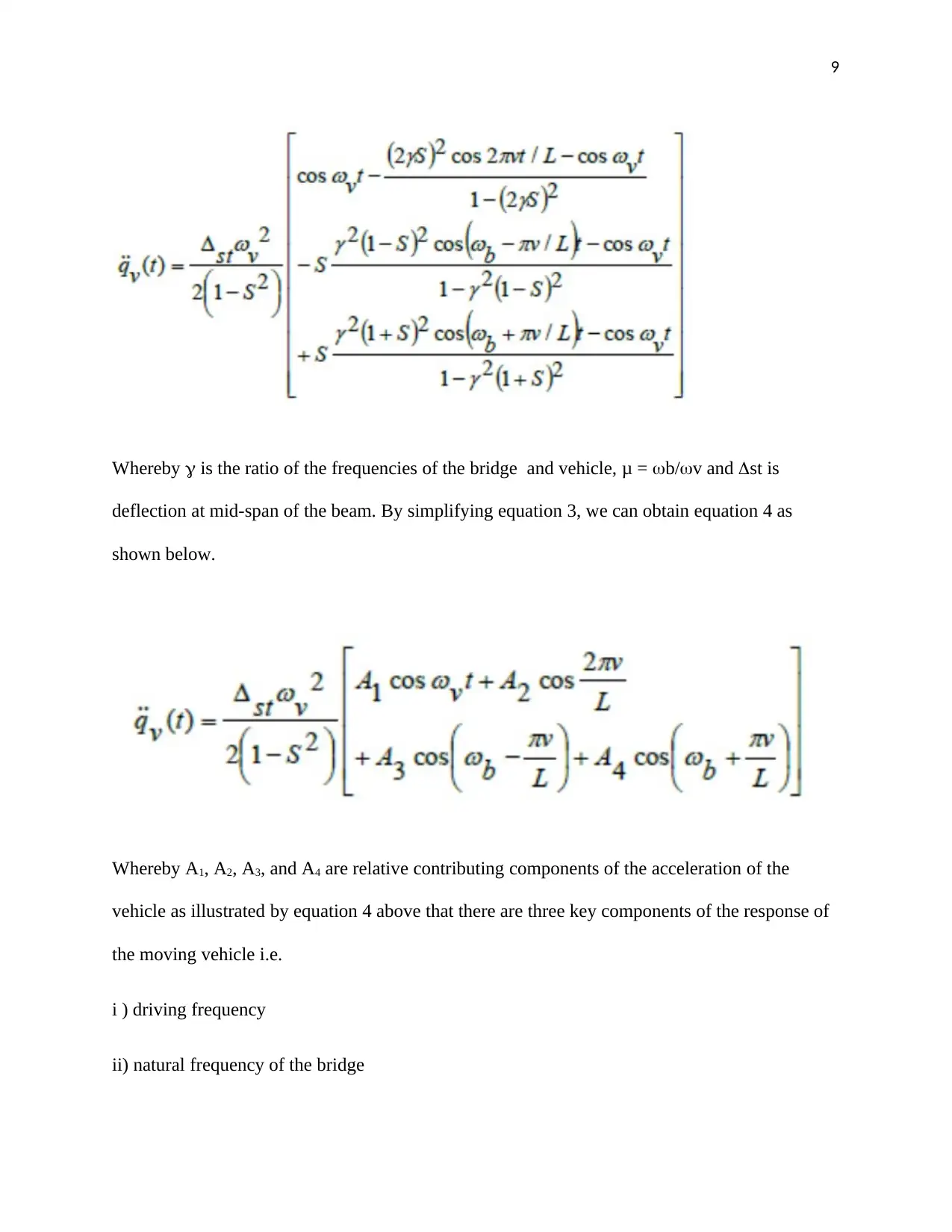
9
Whereby is the ratio of the frequencies of the bridge and vehicle, μ = b/v and st is
deflection at mid-span of the beam. By simplifying equation 3, we can obtain equation 4 as
shown below.
Whereby A1, A2, A3, and A4 are relative contributing components of the acceleration of the
vehicle as illustrated by equation 4 above that there are three key components of the response of
the moving vehicle i.e.
i ) driving frequency
ii) natural frequency of the bridge
Whereby is the ratio of the frequencies of the bridge and vehicle, μ = b/v and st is
deflection at mid-span of the beam. By simplifying equation 3, we can obtain equation 4 as
shown below.
Whereby A1, A2, A3, and A4 are relative contributing components of the acceleration of the
vehicle as illustrated by equation 4 above that there are three key components of the response of
the moving vehicle i.e.
i ) driving frequency
ii) natural frequency of the bridge
⊘ This is a preview!⊘
Do you want full access?
Subscribe today to unlock all pages.

Trusted by 1+ million students worldwide
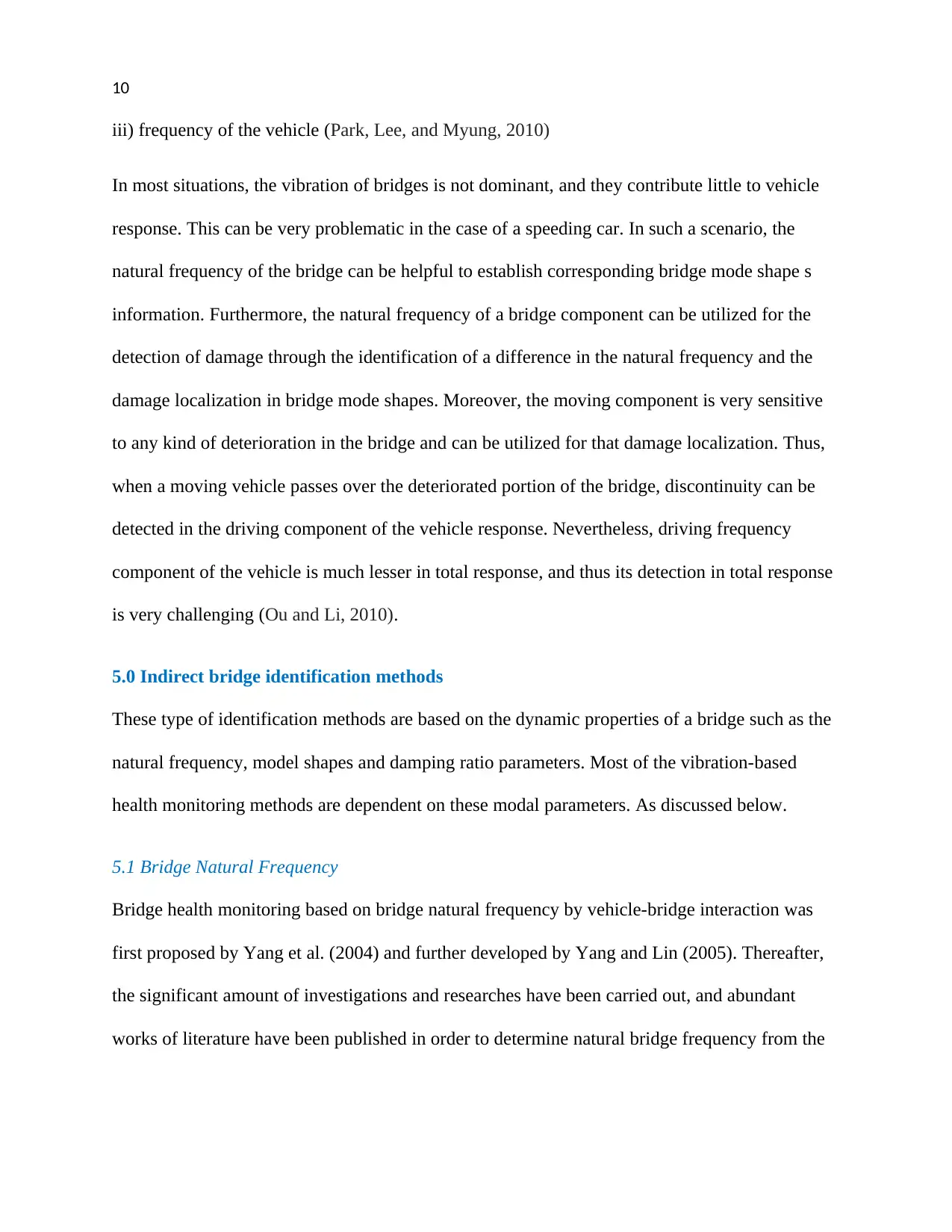
10
iii) frequency of the vehicle (Park, Lee, and Myung, 2010)
In most situations, the vibration of bridges is not dominant, and they contribute little to vehicle
response. This can be very problematic in the case of a speeding car. In such a scenario, the
natural frequency of the bridge can be helpful to establish corresponding bridge mode shape s
information. Furthermore, the natural frequency of a bridge component can be utilized for the
detection of damage through the identification of a difference in the natural frequency and the
damage localization in bridge mode shapes. Moreover, the moving component is very sensitive
to any kind of deterioration in the bridge and can be utilized for that damage localization. Thus,
when a moving vehicle passes over the deteriorated portion of the bridge, discontinuity can be
detected in the driving component of the vehicle response. Nevertheless, driving frequency
component of the vehicle is much lesser in total response, and thus its detection in total response
is very challenging (Ou and Li, 2010).
5.0 Indirect bridge identification methods
These type of identification methods are based on the dynamic properties of a bridge such as the
natural frequency, model shapes and damping ratio parameters. Most of the vibration-based
health monitoring methods are dependent on these modal parameters. As discussed below.
5.1 Bridge Natural Frequency
Bridge health monitoring based on bridge natural frequency by vehicle-bridge interaction was
first proposed by Yang et al. (2004) and further developed by Yang and Lin (2005). Thereafter,
the significant amount of investigations and researches have been carried out, and abundant
works of literature have been published in order to determine natural bridge frequency from the
iii) frequency of the vehicle (Park, Lee, and Myung, 2010)
In most situations, the vibration of bridges is not dominant, and they contribute little to vehicle
response. This can be very problematic in the case of a speeding car. In such a scenario, the
natural frequency of the bridge can be helpful to establish corresponding bridge mode shape s
information. Furthermore, the natural frequency of a bridge component can be utilized for the
detection of damage through the identification of a difference in the natural frequency and the
damage localization in bridge mode shapes. Moreover, the moving component is very sensitive
to any kind of deterioration in the bridge and can be utilized for that damage localization. Thus,
when a moving vehicle passes over the deteriorated portion of the bridge, discontinuity can be
detected in the driving component of the vehicle response. Nevertheless, driving frequency
component of the vehicle is much lesser in total response, and thus its detection in total response
is very challenging (Ou and Li, 2010).
5.0 Indirect bridge identification methods
These type of identification methods are based on the dynamic properties of a bridge such as the
natural frequency, model shapes and damping ratio parameters. Most of the vibration-based
health monitoring methods are dependent on these modal parameters. As discussed below.
5.1 Bridge Natural Frequency
Bridge health monitoring based on bridge natural frequency by vehicle-bridge interaction was
first proposed by Yang et al. (2004) and further developed by Yang and Lin (2005). Thereafter,
the significant amount of investigations and researches have been carried out, and abundant
works of literature have been published in order to determine natural bridge frequency from the
Paraphrase This Document
Need a fresh take? Get an instant paraphrase of this document with our AI Paraphraser
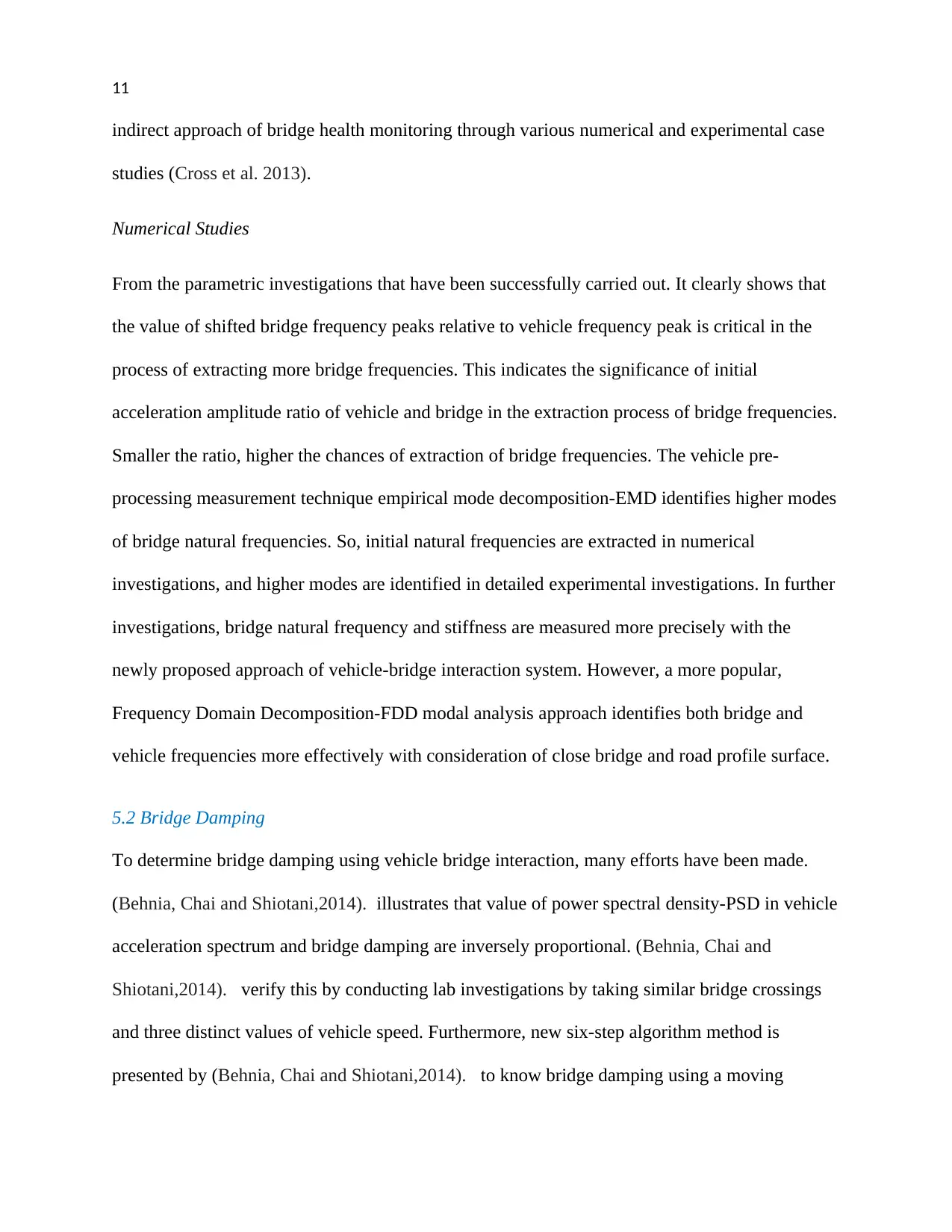
11
indirect approach of bridge health monitoring through various numerical and experimental case
studies (Cross et al. 2013).
Numerical Studies
From the parametric investigations that have been successfully carried out. It clearly shows that
the value of shifted bridge frequency peaks relative to vehicle frequency peak is critical in the
process of extracting more bridge frequencies. This indicates the significance of initial
acceleration amplitude ratio of vehicle and bridge in the extraction process of bridge frequencies.
Smaller the ratio, higher the chances of extraction of bridge frequencies. The vehicle pre-
processing measurement technique empirical mode decomposition-EMD identifies higher modes
of bridge natural frequencies. So, initial natural frequencies are extracted in numerical
investigations, and higher modes are identified in detailed experimental investigations. In further
investigations, bridge natural frequency and stiffness are measured more precisely with the
newly proposed approach of vehicle-bridge interaction system. However, a more popular,
Frequency Domain Decomposition-FDD modal analysis approach identifies both bridge and
vehicle frequencies more effectively with consideration of close bridge and road profile surface.
5.2 Bridge Damping
To determine bridge damping using vehicle bridge interaction, many efforts have been made.
(Behnia, Chai and Shiotani,2014). illustrates that value of power spectral density-PSD in vehicle
acceleration spectrum and bridge damping are inversely proportional. (Behnia, Chai and
Shiotani,2014). verify this by conducting lab investigations by taking similar bridge crossings
and three distinct values of vehicle speed. Furthermore, new six-step algorithm method is
presented by (Behnia, Chai and Shiotani,2014). to know bridge damping using a moving
indirect approach of bridge health monitoring through various numerical and experimental case
studies (Cross et al. 2013).
Numerical Studies
From the parametric investigations that have been successfully carried out. It clearly shows that
the value of shifted bridge frequency peaks relative to vehicle frequency peak is critical in the
process of extracting more bridge frequencies. This indicates the significance of initial
acceleration amplitude ratio of vehicle and bridge in the extraction process of bridge frequencies.
Smaller the ratio, higher the chances of extraction of bridge frequencies. The vehicle pre-
processing measurement technique empirical mode decomposition-EMD identifies higher modes
of bridge natural frequencies. So, initial natural frequencies are extracted in numerical
investigations, and higher modes are identified in detailed experimental investigations. In further
investigations, bridge natural frequency and stiffness are measured more precisely with the
newly proposed approach of vehicle-bridge interaction system. However, a more popular,
Frequency Domain Decomposition-FDD modal analysis approach identifies both bridge and
vehicle frequencies more effectively with consideration of close bridge and road profile surface.
5.2 Bridge Damping
To determine bridge damping using vehicle bridge interaction, many efforts have been made.
(Behnia, Chai and Shiotani,2014). illustrates that value of power spectral density-PSD in vehicle
acceleration spectrum and bridge damping are inversely proportional. (Behnia, Chai and
Shiotani,2014). verify this by conducting lab investigations by taking similar bridge crossings
and three distinct values of vehicle speed. Furthermore, new six-step algorithm method is
presented by (Behnia, Chai and Shiotani,2014). to know bridge damping using a moving

12
vehicle. Further study suggests that this algorithm-based approach eliminates the negative effects
of road surface profile.
7.0 Conclusion
In conclusion, the key objectives of Structural Health Monitoring are to carefully monitor
structural behavior due to varying loading conditions, identify any damage, location and nature
of the damage and to assist the inspection of the structure. Therefore, Structural Health
Monitoring can perform a key role in maintaining and managing these infrastructure systems due
to various security and economic safety reasons.
At present, there are two main methods for Structural Health Monitoring of bridges, i.e., direct
approach and indirect approach. Most of the present monitoring methods are direct approaches in
which sensors are fixed at specific locations of the bridges and data is obtained from them. In
this method of calculating natural bridge frequency and damping ratio of the bridge, it is
observed that those values can be determined using bridge natural frequency component of
vehicle response. However, the road surface profile still affects the accuracy of the results.
Majority of the techniques that are used in the Structural Health Monitoring of the speed of the
vehicle is taken as constant. However, it is not possible to carry the monitoring procedure with
the constant speed, and therefore results are affected. Hence, there is a future scope of speed
variations in bridge health monitoring studies. Finally, the environment where the bridge is
located plays a very crucial role on the bridge damage. This environmental effects can be
incorporated by using a vehicle that passes through the same places regularly, and in such a way
environmental impacts can be omitted (Huston,2010).
vehicle. Further study suggests that this algorithm-based approach eliminates the negative effects
of road surface profile.
7.0 Conclusion
In conclusion, the key objectives of Structural Health Monitoring are to carefully monitor
structural behavior due to varying loading conditions, identify any damage, location and nature
of the damage and to assist the inspection of the structure. Therefore, Structural Health
Monitoring can perform a key role in maintaining and managing these infrastructure systems due
to various security and economic safety reasons.
At present, there are two main methods for Structural Health Monitoring of bridges, i.e., direct
approach and indirect approach. Most of the present monitoring methods are direct approaches in
which sensors are fixed at specific locations of the bridges and data is obtained from them. In
this method of calculating natural bridge frequency and damping ratio of the bridge, it is
observed that those values can be determined using bridge natural frequency component of
vehicle response. However, the road surface profile still affects the accuracy of the results.
Majority of the techniques that are used in the Structural Health Monitoring of the speed of the
vehicle is taken as constant. However, it is not possible to carry the monitoring procedure with
the constant speed, and therefore results are affected. Hence, there is a future scope of speed
variations in bridge health monitoring studies. Finally, the environment where the bridge is
located plays a very crucial role on the bridge damage. This environmental effects can be
incorporated by using a vehicle that passes through the same places regularly, and in such a way
environmental impacts can be omitted (Huston,2010).
⊘ This is a preview!⊘
Do you want full access?
Subscribe today to unlock all pages.

Trusted by 1+ million students worldwide
1 out of 15
Your All-in-One AI-Powered Toolkit for Academic Success.
+13062052269
info@desklib.com
Available 24*7 on WhatsApp / Email
![[object Object]](/_next/static/media/star-bottom.7253800d.svg)
Unlock your academic potential
Copyright © 2020–2025 A2Z Services. All Rights Reserved. Developed and managed by ZUCOL.
